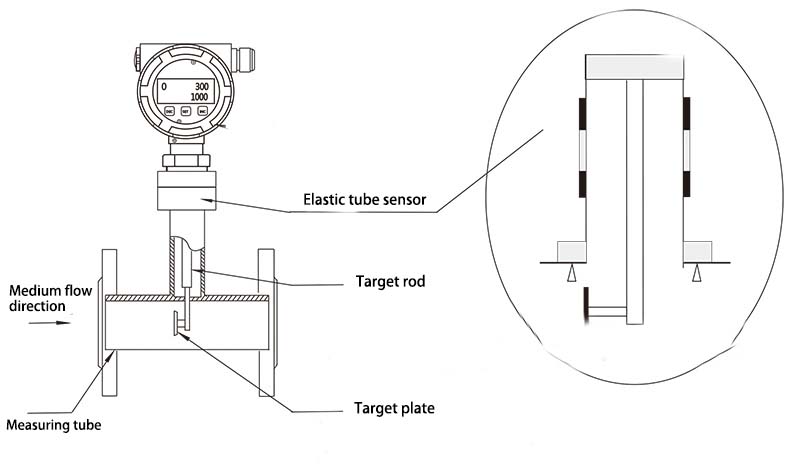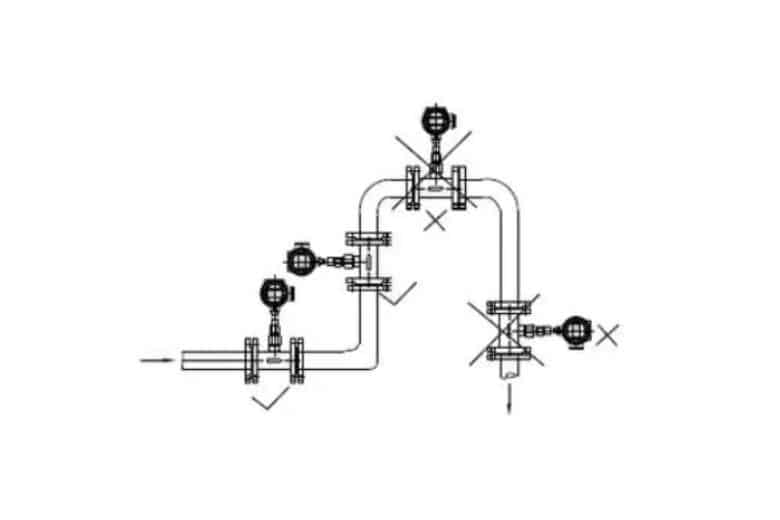Target flow meters play a vital role in industry and science, not only by accurately measuring the flow of fluids but also by providing real-time data to support the control and optimization of production processes.
Working principle of target flow meter
A target flow meter is a fluid flow measurement device whose principle is based on the change in resistance or pressure difference of a fluid in a pipe. First, fluid flow through a pipe creates friction and resistance against the pipe walls, resulting in a certain pressure difference inside the pipe. The target flow meter utilizes this pressure difference to push the fluid through the meter and determines the flow rate by measuring the pressure difference created as the fluid passes through.
Secondly, the target-type flow meter is usually equipped with a target body, fluid flow through the target body will change its flow state, so the fluid flows through the target-type flow meter when the pressure difference changes. Finally, by measuring this pressure difference, the target flow meter can accurately calculate the flow rate of the fluid. Therefore, the target-type flow meter has high accuracy and reliability by utilizing the change of resistance or pressure difference of the fluid in the pipeline to realize the flow measurement.
Mathematical formulas for target flow meters:
- A mathematical model can represent the sensor part as:

Where ΔP denotes the pressure difference created by the passage of the fluid, Q denotes the flow rate, and K and n are specific parameters of the sensor.
- A mathematical model of the measuring device can be expressed as follows:

Where Q is the flow rate, ΔP is the pressure difference detected by the sensor, and f(ΔP) is a function of the flow rate value calculated from the pressure difference output by the sensor.
Through the above mathematical model, the target flow meter can realize the accurate measurement and output of fluid flow. The sensor part determines the flow rate by the pressure difference generated when the fluid flows, while the measuring device part calculates the actual flow rate value based on the pressure difference of the sensor output.
Internal structure of target flow meter
The internal structure of a target flow meter consists of a sensor and a measuring device. First, the sensor, usually located inside the pipe of the flow meter, is responsible for detecting pressure differences or resistance changes that occur as the fluid passes through. The sensor can be a sensitive element based on pressure sensing technology or changes in resistance and is designed to accurately capture pressure changes as the fluid flows.

Next, the measuring device is the component that converts the signal captured by the sensor into a readable flow value. The measuring device usually consists of a microprocessor, a display, and an electronic controller, among other things, which are used to process the data captured by the sensor and calculate an accurate flow rate value based on preset algorithms and calibration values. Finally, the internal structure of the target flow meter is compactly designed to ensure the stability and reliability of the sensor and the measuring device. The synergy between the sensor and the measuring device enables the target flow meter to accurately measure the flow rate of the fluid and provide accurate data output.
Types of target flow meters
- Insertion flow meter: An insertion flow meter is a flow measurement device that can be inserted into a pipe. It realizes flow measurement by inserting the measuring probe inside the pipeline so that the probe is located in the fluid flow path. Insertion target flow meters are suitable for established piping systems and can be easily installed and maintained.
- Pipeline target flow meter: A pipeline target flow meter is a kind of flow measurement equipment installed directly inside the pipeline. It usually consists of a target plate and a sensor, the target plate is located in the pipeline, while the sensor is installed on the outside of the pipeline, and is used to detect the target plate by the force or flow conditions. A Pipeline target flow meter is suitable for the requirement of direct measurement of fluid flow in the pipeline, can provide accurate flow data, and easy to install, and does not affect the normal operation of the pipeline.
Target flow meter correct installation direction
- Horizontal installation: In most cases, the target flow meter should be installed horizontally in the pipe. This can minimize the pipeline turbulence and eddy current on the measurement of interference, and ensure that the fluid can flow evenly through the target plate, improving the accuracy of measurement.
- Vertical installation: In some special cases, the target flow meter can be installed vertically in the pipeline. For example, in the vertical rise or fall of the pipeline, vertical installation can be better adapted to the direction of fluid flow, and to ensure that the fluid flows smoothly through the target plate for measurement.
- Direction of flow: When installing a target flow meter, you should make sure that the direction of fluid flow is consistent with the design direction of the target plate. This will ensure that the fluid can correctly target plate force, and ensure the accuracy of measurement.
- Pipe diameter and flow rate: In the choice of installation location, the pipe diameter and flow rate on the impact of flow measurement. Typically, the target flow meter should be installed at a certain distance from the pipe diameter to ensure the stability and uniformity of the fluid flow.

Application areas of target flow meters
The target flow meter is a commonly used flow measurement device for a wide range of industrial and scientific applications. The following are some of the main application areas for target flow meters:
- Chemical industry: In the chemical industry, the target flow meter is commonly used to measure the flow of various liquids and gases, for monitoring and controlling the flow of fluids in the production process, such as in the chemical reactor, pipeline conveying system, and so on.
- Oil and gas industry: target flow meter is widely used in oil and gas extraction, transportation and processing of flow measurement, for monitoring and control of oil and gas well production, pipeline transportation flow, etc..
- Pharmaceutical industry: in the pharmaceutical industry, a target flow meter is commonly used in the pharmaceutical production process of flow measurement, to ensure that the fluid flow in the pharmaceutical production process is accurately controlled to ensure product quality.
- Laboratory research: in the field of scientific research, the target flow meter is commonly used in the laboratory on the fluid flow properties of research and measurement, such as in fluid mechanics, fluid dynamics, and other areas of the experiment.
- Water treatment and environmental protection: A target flow meter can be used to monitor and control the flow of fluids in the environment of sewage treatment, water supply system, etc., to ensure the effective use of water resources and environmental protection.
- Air conditioning and heating systems: In the air conditioning and heating systems of buildings, target flow meters can be used to measure the flow of coolant, heating, and other fluids to ensure the operational efficiency and stability of air conditioning and heating systems.
- Automotive engineering: in the field of automotive engineering, the target flow meter is commonly used to measure the fuel flow and airflow of automobile engines, which is used to optimize engine performance and fuel economy.
- Food processing: In the food processing industry, a target flow meter can be used to measure the fluid flow in the food production process, such as in beverage production, food conveying pipelines, and other applications.
Advantages of target flow meters
- High accuracy: The target flow meter has a high degree of measurement accuracy and is capable of providing accurate and reliable flow data. Its structural design and measuring principle enable it to realize stable and accurate measurements under various fluid conditions.
- Reliability: The target-type flow meter has high reliability and stability, and can maintain accurate measurement performance during long-term use. Its simple structural design and reliable measurement principle make it have a low failure rate and maintenance costs.
- Wide applicability: The target flow meter is suitable for a variety of media and working conditions, including liquid, gas, and corrosive media. It can be used in a variety of industrial fields and application scenarios to meet the needs of different industries on flow measurement.
- Easy to operate: The target flow meter has a simple and easy-to-understand operating interface and operating procedures, easy to use. Usually only need to install, calibrate, and maintain the instrument to realize normal measurement operation.
- High pressure and temperature adaptability: Target-type flow meters can adapt to high-pressure and high-temperature working environments, with strong pressure resistance and temperature resistance. This means it can be used in some harsh industrial scenarios, such as chemical, petroleum, and other industries.
- Low-pressure drop: the target flow meter’s structural design allows it to have low-pressure drop characteristics, the fluid flow of the pipeline system has no significant impact on the fluid flow, to maintain the stability and efficiency of the fluid flow.
- Environmental protection and energy saving: The target type flow meter adopts a mechanical structure and traditional measurement principle, and does not need an external energy supply, energy saving and environmental protection. At the same time, its high-precision measurement capability can help enterprises to achieve energy saving and emission reduction, and optimization of resource utilization.
Summary
As a key flow measurement device, the target flow meter has importance and advantages in industrial and scientific fields. Its high accuracy, reliability, wide applicability, easy operation, high pressure, and temperature resistance, as well as environmental protection and energy-saving features, make it the preferred tool for monitoring and controlling the flow of fluids, and it has an irreplaceable role in guaranteeing the stable operation of the production process and optimizing the use of resources.
Apure offers different types of flow meters which include magnetic flow meters, vortex flow meters, turbine flow meters, ultrasonic flow meters, and float flow meters. If you want to know how to choose the right flow meter for you, please contact us.
